Kia’s Flagship Sedan is Vanilla No More
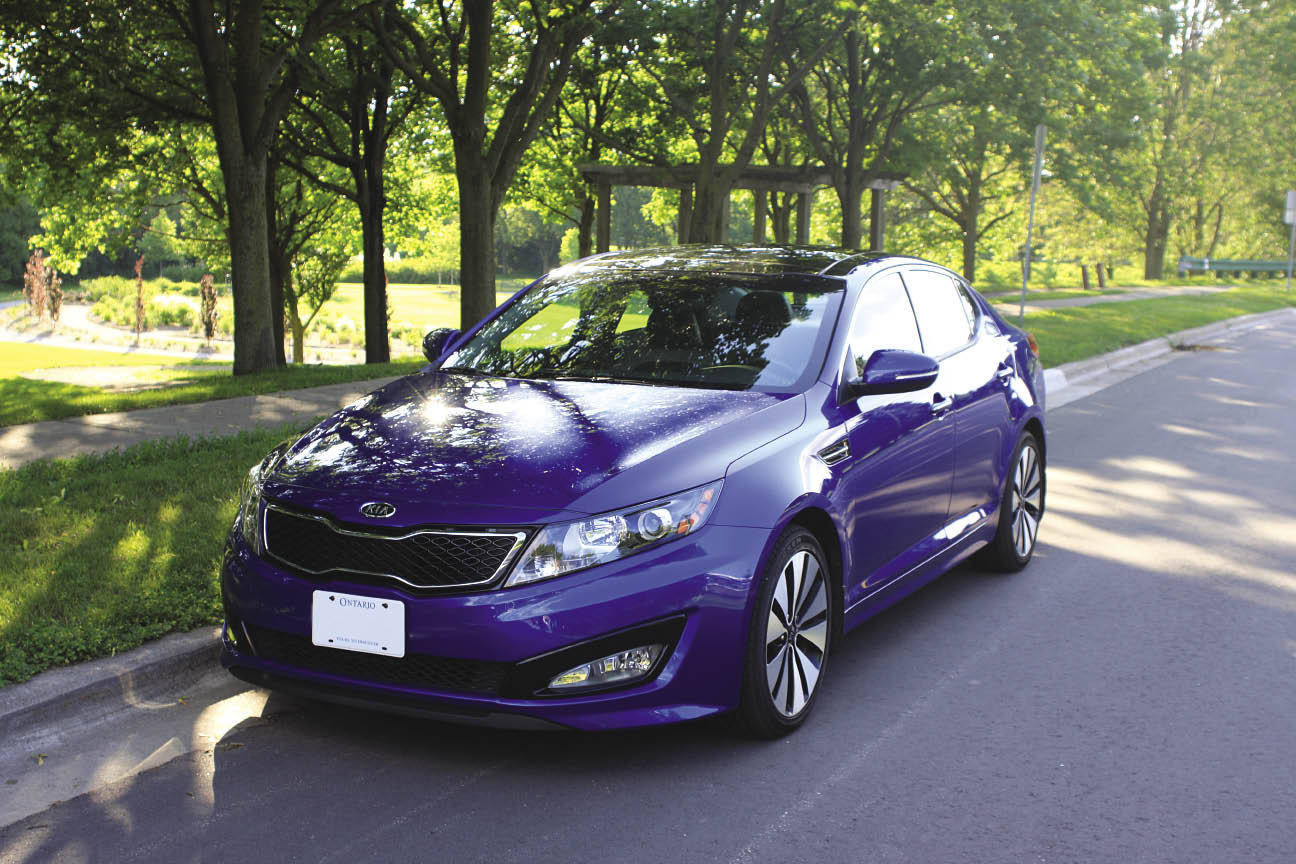 I didn’t know how long the predecessor for the all-new 2011 Kia Optima had been in the Korean automaker’s lineup, so I had to look it up. To my surprise, the Kia Magentis (it was called the Optima in the U.S. and Singapore) existed in essentially the same form – with some styling updates – for nearly a decade (2002-2010).
I didn’t know how long the predecessor for the all-new 2011 Kia Optima had been in the Korean automaker’s lineup, so I had to look it up. To my surprise, the Kia Magentis (it was called the Optima in the U.S. and Singapore) existed in essentially the same form – with some styling updates – for nearly a decade (2002-2010).
Although Kia made a greater effort to distinguish it from its corporate cousin upon which it was based (Hyundai Sonata) with a 2005 redesign and a 2008 update, the Magentis was a fairly anonymous flagship car.
Inoffensive but bland styling inside and out combined with average performance and build quality summed up the Magentis.
Not great, nor awful, the Magentis was a pretty unremarkable car. Last fall, Subaru’s American division had a little fun at Kia’s expense when it created a cheeky viral marketing campaign for the Legacy entitled ‘The 2011 Mediocrity’, about a fictitious automaker whose primary goal was to build ordinary cars that weren’t special or distinguishable from the competition in any way – the ultimate vanilla car.
And which car did Subaru base the Mediocrity campaign on?
The Kia Magentis, circa 2002. Ouch.
With the outgoing model setting the bar so low, it would have been difficult for Kia to not to improve upon it with the launch of the Optima.
On that score, mission accomplished – big time.
The Optima represents a clean-sheet approach in every way, from the engines to the styling to the performance and car’s positioning in the market. It is everything the Magentis wasn’t and then some.
The Optima is designed to turn heads and make a splash, and it has certainly done that.
The company’s US division had sold more than twice as many Optimas through June 2011 (36,617) as it did with the old model over the same time period in 2010 (15,627).
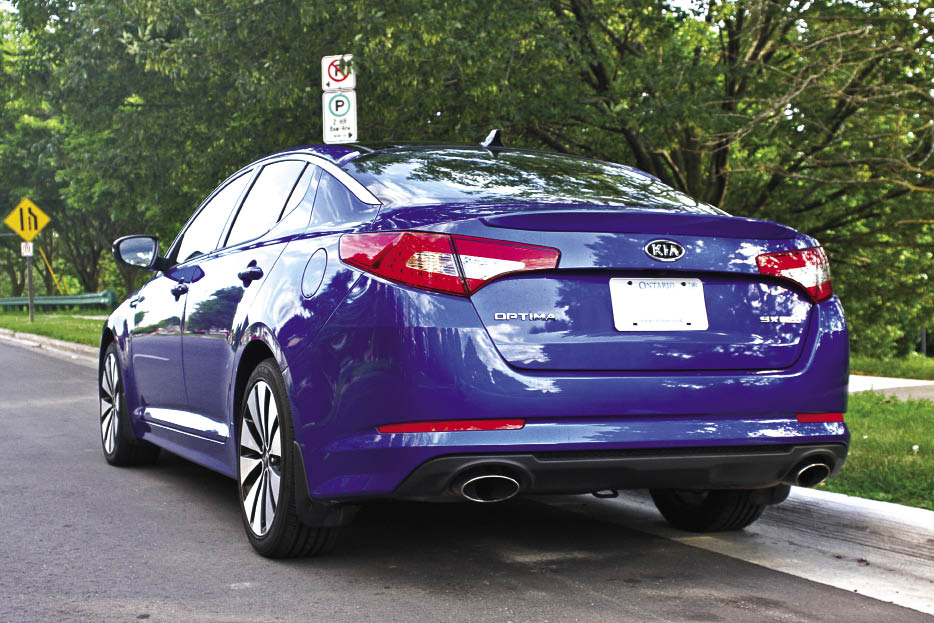 Specific sales figures for the Optima in Canada haven’t been made available, but Kia Canada Inc. recently reported its best sales month ever in June 2011 with 7,077 units sold. Given the scarcity of Optimas on dealer lots at the moment (at this writing there were only three at my local dealer, including one in the showroom), it’d be safe to assume the Optima has done its part to contribute to that number. The Optima sports a much more aggressive and sleeker appearance that the Magentis and shares much of the company’s design cues, including the very prominent Tiger Nose, the corporate grille penned by Peter Schreyer, Kia’s Chief of Design that appears on all of the company’s cars.
Specific sales figures for the Optima in Canada haven’t been made available, but Kia Canada Inc. recently reported its best sales month ever in June 2011 with 7,077 units sold. Given the scarcity of Optimas on dealer lots at the moment (at this writing there were only three at my local dealer, including one in the showroom), it’d be safe to assume the Optima has done its part to contribute to that number. The Optima sports a much more aggressive and sleeker appearance that the Magentis and shares much of the company’s design cues, including the very prominent Tiger Nose, the corporate grille penned by Peter Schreyer, Kia’s Chief of Design that appears on all of the company’s cars.
It is also wider, longer and slightly shorter than its predecessor which is in keeping with the company’s aim to position the Optima as a sportier entry in the midsize segment. This also serves to differentiate it from the Sonata, with which it shares engines and other components.
Given the importance of this car for Kia and the fanfare it came to market with (there were some pretty flashy Super Bowl ads when it was rolled out in the U.S.), I was eager to get behind the wheel of one. My tester was a bright royal blue (Santorini Blue officially), top-of-the-line SX model which comes with a six-speed automatic transmission mated to a 2.0 litre direct-injected turbocharged inline 4-cylinder engine. Despite its small displacement, the mill cranks out 274 horsepower and 269 lb.-ft. of torque.
The rest of the line gets a 2.4 litre inline four that puts out 200 horsepower and 186 lb-ft. of torque. By comparison, the most powerful engine in the Magentis lineup, was a 2.7 litre V6 that produced 194 horsepower and 184 lb.-ft. of torque.
Clearly, Kia realizes that solid performance credentials are necessary for the Optima to establish itself as a legitimate player in a segment that also includes Honda Accord, Nissan Altima, Ford Fusion and the aforementioned Sonata among others. Aside from a more muscular powerplant, the SX model also features a lengthy list of standard features, including a leather trimmed interior, heated and cooled seats, Infinity premium sound system, panoramic sunroof, navigation system with a backup camera, push button ignition and 18” alloy wheels.
Underpinning the Optima SX is a sport-tuned suspension featuring McPherson struts up front and a multi-link setup in the rear, which Kia claims provides faster steering response, reduced body roll in turns and increased road feel. The suspension also features Kia’s High Performance Dampers which are designed to provide more proportionate damping action on both smooth and rough driving surfaces.
IMPRESSIONS
The Optima is a handsome car in photos, but it looks even better in person, in my view. The styling, with its crisp, sharp lines give the car an aggressive feel, yet have a clean elegance about them are the automotive equivalent of a well-made suit that has been pressed to perfection.
It’s a look that is both athletic and sophisticated; kudos to Schreyer and his team for crafting a winning design. Some at our offices didn’t care for the food processor blade-styled wheels, but I thought they looked great.
I was also quite impressed with the interior, which felt like it has received a boost in both design and materials. The leather seats were quite comfortable and I was able to find a good driving position fairly easily, thanks in part to the power controls on the driver’s seat.
The dash was finished in a textured plastic that might not have been the softest or most expensive, but it looked pretty good and didn’t scream cheap. Sliding behind the leather-wrapped steering wheel, I was impressed to see the centre stack angled towards the driver. I found this to be especially useful, because it contains some of the most-used controls: stereo, climate and navigation. Some of these controls are also on the steering wheel, such as those belonging to the stereo, but I tend to rely on the centre stack more often – too many years spent driving cars with nothing on the steering wheel except for the horn, I guess – so I appreciated having them within easy reach.
Although there were a number of buttons – inevitable on a car with this much stuff – I wasn’t overwhelmed by them and they all seemed to be in a logical place. The push button start took a little getting used to, but it became second nature after a while. Same goes for Kia’s hello and goodbye messages on the instrument cluster and their accompanying chimes. They caught me a little off-guard at first although I became used to them as the week work wore on. I found the navigation system and backup camera to be quite useful. The navi features a large screen which was both easy to read and to use, and the backup camera was handy for getting in and out of tight spaces.
I had a week with this car, so I was able to drive it in a variety of road surfaces in both wet and dry conditions, on city streets (some of which are in exceedingly poor repair), suburban arterial roads and busy highways in and around greater Toronto. The Optima SX handled all of them capably. The cabin was quiet (especially at cruising speeds), but the turbocharged four could definitely be heard – and felt – under acceleration.
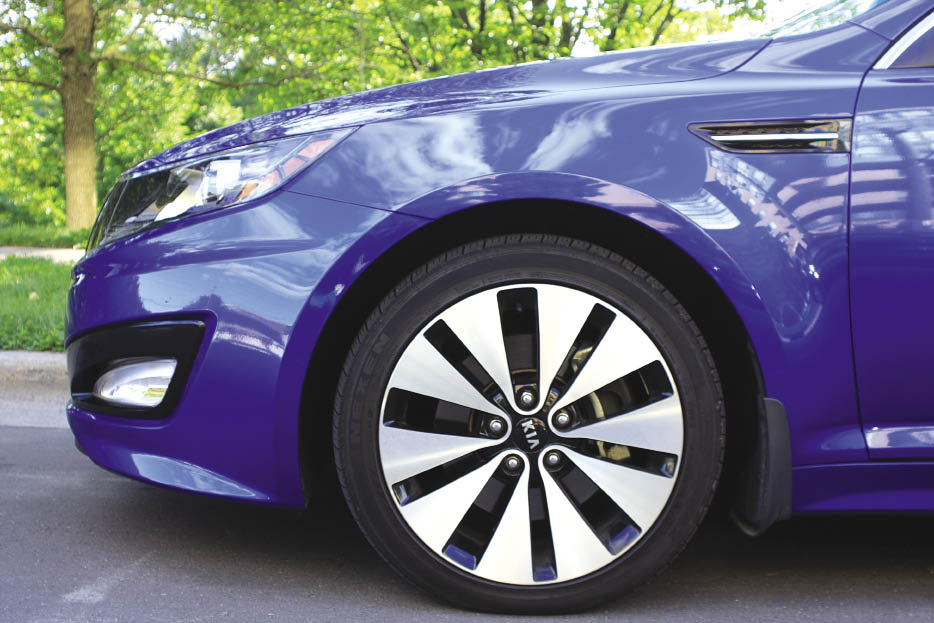 |
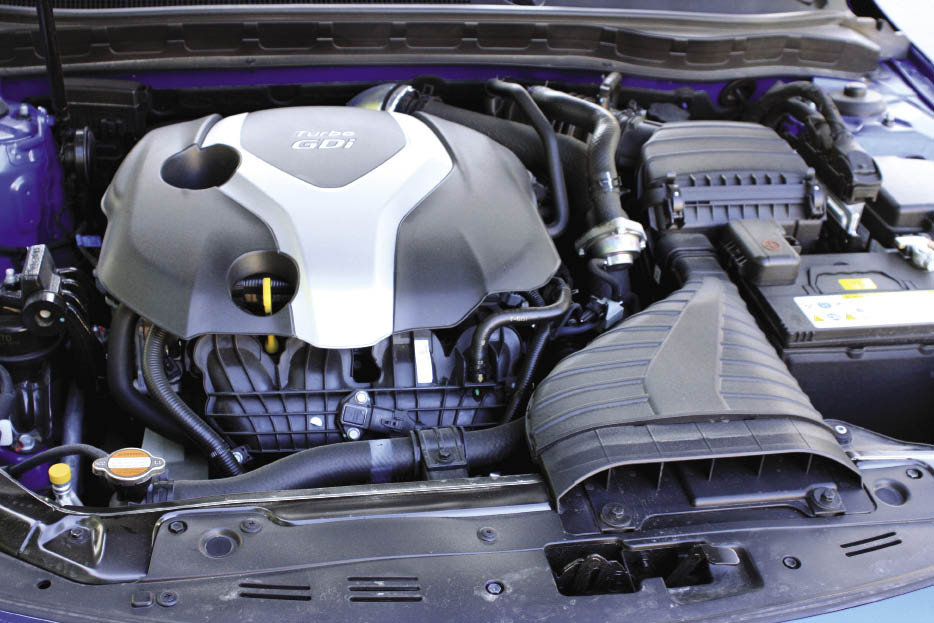 |
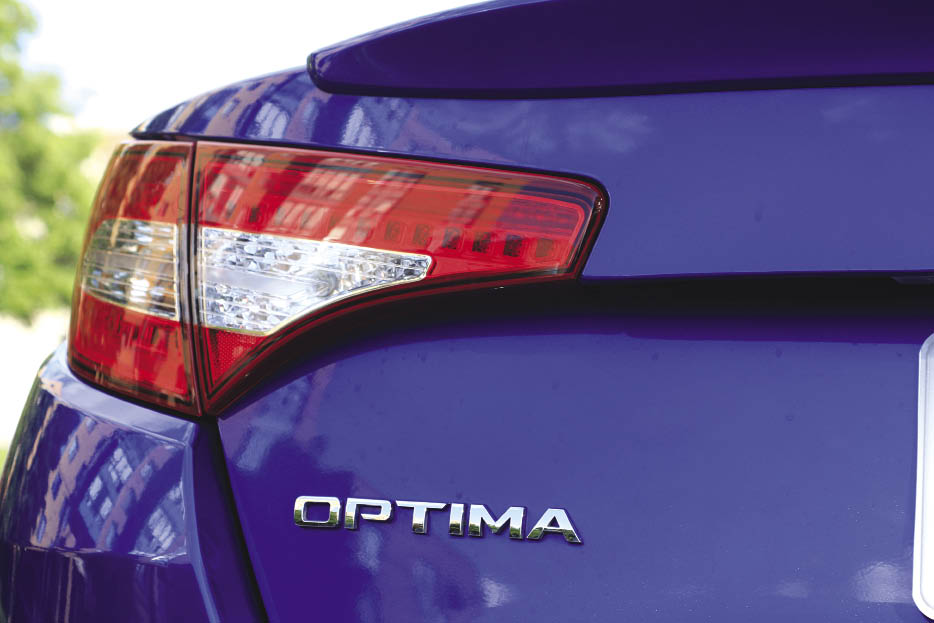 |
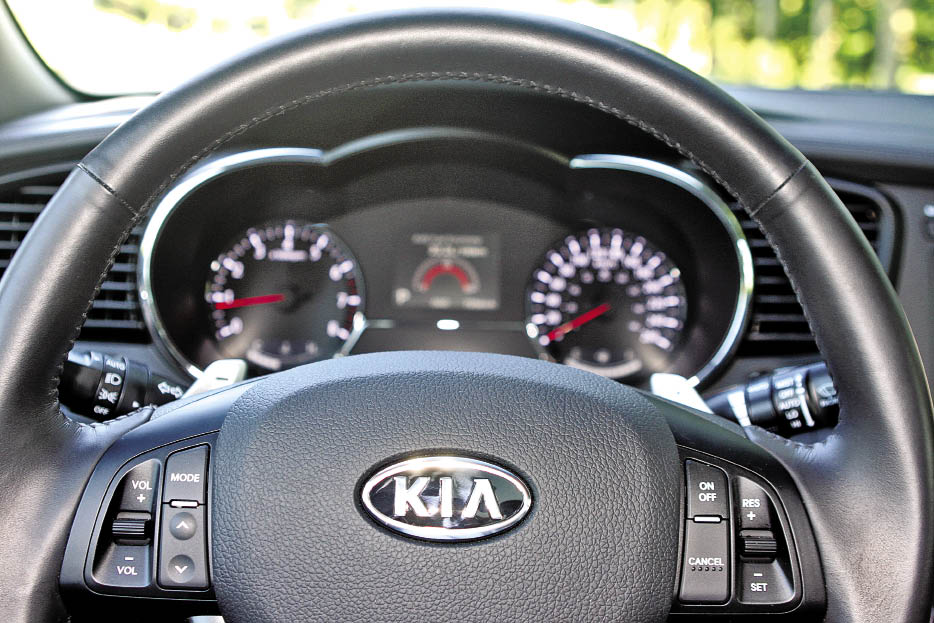 |
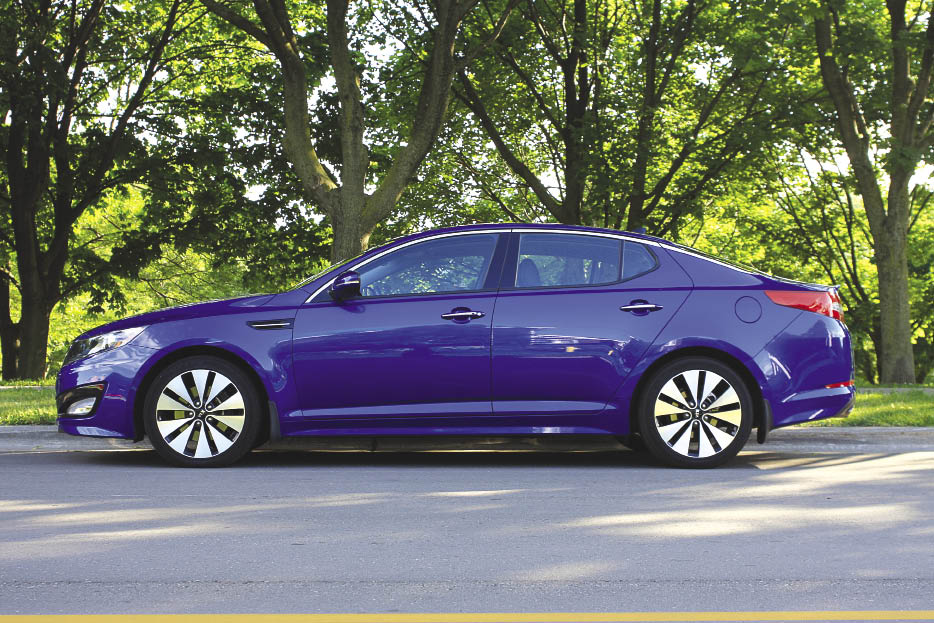 |
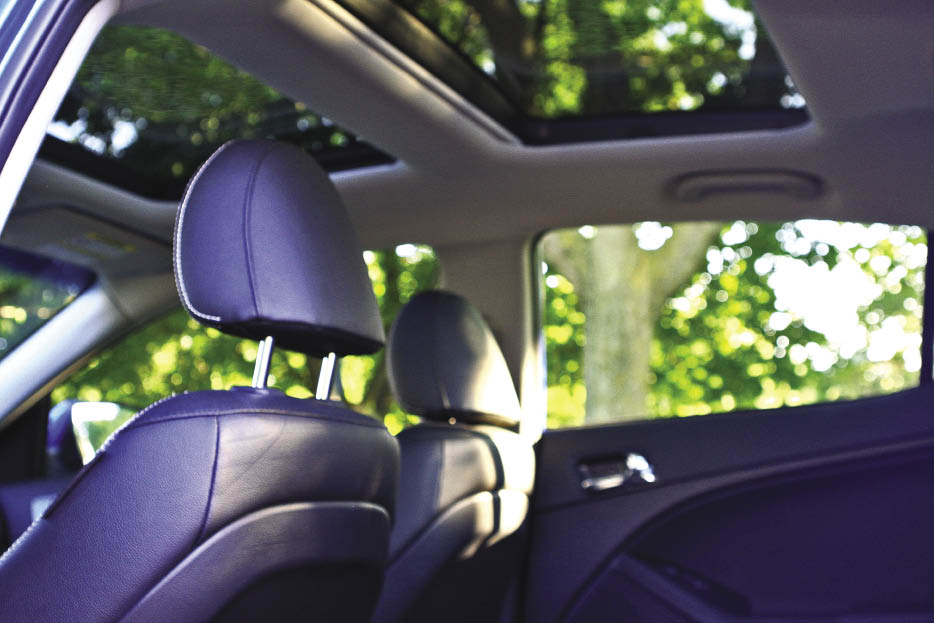 |
Acceleration was brisk and on-demand. One not need stand on the accelerator to get this car to move, but if you do (as I did a couple of times), expect to exceed posted speed limits in a hurry. Passing was a breeze. This model is tuned for performance, so the ride was firm, but not uncomfortable. The steering didn’t have a go-kart feel, but compared to what it’s up against in this class, it felt reasonably responsive. Coupled with larger wheels and low-profile Nexen tires the handling was confident.
The six-speed automatic (no manual available for this model, sadly) was smooth and came with a manual mode, which worked quite well.
To further drive home the point that this is a performance model, Kia has also equipped the SX with paddle shifters on the steering column. They don’t exactly make you feel like you’re ready for the Indy 500, but were fun to play with all the same. As mentioned, this is the highest trim level Optima, so all of the fun doesn’t come cheap.
With that said, the SX's $33,695 price tag is right in the middle of the pack of optioned-out, mid-sized sedans from Kia's competitors at Honda, Toyota, Nissan and Hyundai among others. The value proposition is further enhanced by the fact that you won’t want for anything if you pick this car – it comes fully loaded.
Decent performance isn’t limited to SX buyers, however; even the base LX model ($21,995) comes with the 200 horsepower, 2.4 litre inline four.
Kia has done one impressive job over the past few years of shedding its staid and cheap reputation, and recasting itself as a brand of style and performance. With such a strong, good-looking and well-equipped performer like the Optima rounding out its lineup, Kia’s strong sales growth should continue for some time to come.
2011 Kia Optima SX Specifications
| Base price / as tested | $33,695 / $35,250 |
| Engine | 2.0-litre direct injected turbocharged DOHC inline 4-cylinder |
| Output | 274 hp @ 6,000 rpm / 269 lbs.-ft. torque @ 1,750-4,500 rpm |
| Platform | FF |
| Fuel Consumption (manufacturer) | City – 9.2L/100 km (31 mpg); Highway – 5.8L/100 km (49 mpg) |






















